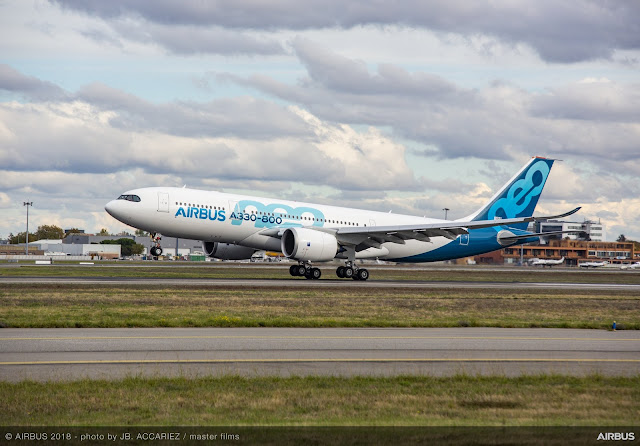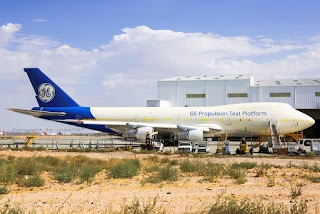The year 2018 was a year rich in aeronautical events. Mergers, certifications of new aircraft, new orders and deliveries, which have increased in pace, have marked this year. Here is a retrospective of the year 2018.
 |
The first flight of the A330-800 neo (source:Airbus)
|
Airbus expands its range of long-haul aircraft
We start with Airbus, which will be managed by Guillaume Faury from April 2019, after conflicts between Tom Enders and Fabrice Brégier (the latter resigns in February 2018). New aircraft were presented. The A319 was certified in December for its version equipped with CFM International LEAP-1A engines. The A350-1000 entered service with Qatar Airways in February after being certified by ESA and FAA. The
A330-800 (the shortest version of the A330 neo series) made its first flight and the A330-900 was certified by ESA in September, then delivered to TAP Portugal, its launch company. On the long-haul side, the European manufacturer witnessed the first flights of the A350-900ULR, which linked Singapore to New York (the longest commercial route in the world) and the first delivery of the A321LR, to Arkia Israeli Airlines, a single-aisle aircraft with a 7400 km range. The A380 program is continuing, thanks in particular to Emirates, which has
ordered 20 A380s with 16 aircraft in options.
In addition, other non-commercial aircraft were presented. The ACJ320 neo has become a new Airbus VIP model, the A320 has been declined in military version (for maritime surveillance) and the BelugaXL has made its first flight, which can eventually carry 2 A350 wings. The device should soon be certified and put into service.
Boeing expects new aircraft
Across the Atlantic, Boeing has unveiled the first images of its next long-haul aircraft, the
777X, which is expected to take off in early 2019. The prototype is currently in the assembly line. The 787-10 obtained FAA certification in January 2018, becoming the largest version of the Dreamliner. Boeing is also looking to develop an NMA, New Midsize Airplane, a wide-body aircraft that could have a cost per seat comparable to single-aisle aircraft. The Boeing 737-10 MAX is also being prepared, with a first flight scheduled for late 2019 and commissioning in 2020. The Boeing 737 MAX and 787 continue to sell worldwide, allowing the American aircraft manufacturer to deliver 810 to 815 aircraft in 2018. At the end of November, it totalled 690 new orders excluding cancellations, compared with 439 for Airbus.
 |
| The first Boeing 777X (source:airline ratings) |
In business aviation, Boeing completed its range with the first flight of the BBJ MAX 8 on April 16 and the presentation of the BBJ 777X, which succeeded the BBJ 777 in December.
 |
| A Boeing BBJ MAX in flight (Source:the Boeing) |
Many mergers and partnerships
2018 was also a year of rapprochement in the aeronautics sector. Bombardier's CSeries program has joined the
Airbus range, renaming it A220, the first A220 was delivered to Delta Airlines in October and Airbus plans to open a second assembly line in Mobile, Alabama (USA) in 2020. To counter this transfer of program to Airbus,
Boeing announced the creation of a joint venture with Embraer, which it owns 80% of. Embraer announced that it had delivered a total of 1500 aircraft and delivered its first E-190-E2, a more fuel-efficient version than the Embraer E190, to Widerøe, after being certified by ANAC, FAA and ESA in March. Concerning ATR, the aircraft manufacturer has delivered its 1500th aircraft. It has also launched a partnership with Air New Zealand to develop the future of regional aviation, with electric and hybrid aircraft for example.
 |
| An A220 of Delta (source:ainonline) |
New from Russian and Asian manufacturers
The
Chinese Comac, for its part, carried out tests on the third prototype of the C919, its future medium-haul aircraft. In Japan, the MRJ 90, a short-haul aircraft from Mitsubishi Regional Jet, was certified by the Japanese Civil Aviation Bureau on December 21. The aircraft is expected to be certified by the FAA in the near future with commissioning planned for 2020. In Russia, Sukhoi Civil Aircraft plans to deliver 28 aircraft in 2019 and has received new orders this year for its SSJ-100 regional aircraft, with 100 aircraft for Aeroflot
Dassault presented the
Falcon 2000 MSA, with a rare photography of the maritime surveillance device, intended for the Japanese coastguard. In business aviation, the Falcon 6X was introduced on February 28, 2018 for commissioning in 2022. Bombardier, for its part, presented the Global 7500, a business jet with a range of 13,705 km.
 |
| The Falcon 6X presented (source:Wikipedia) |
Among aircraft equipment manufacturers, there have also been mergers with Zodiac Aerospace, which joined Safran on February 13, forming the world's third largest aerospace group. Three new subsidiaries have been created to take over Zodiac's activities: Safran Seats, Safran Cabin and Safran Aerosystems.
 |
| Merger of Zodiac Aerospace and Safran (source: challenges) |
New ramp-ups
There have also been increases in production rates, particularly with engine manufacturers. For example, CFM International (a joint venture between GE Aviation and Safran Aircraft Engines) has grown from 459 engines delivered to over 1000 this year, despite some technical issues that had to be resolved on the Leap-1B, which caused major delays. In April, Airbus announced an increase in production on the A320 assembly line. The manufacturer wishes to increase from 50 to 63 new single-aisle aircraft, for a rate of 70 to 75 A320 neo per month in the long term. Indeed, demand is always increasing and manufacturers cannot deliver airlines quickly. An airline ordering an A320 can only be delivered from 2023-2024. Emerging countries such as
China present an opportunity for future orders.
You liked this article? Please share it! Thank you!😀
👇











Comments
Post a Comment